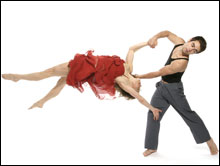 Larry Keigwin’s dance is mostly about sex: homosex, heterosex, kinky, tender, tragic, contentious, friendly, and even subliminal sex. Keigwin + Company, presented at Zero Arrow Theatre last weekend by CRASHarts, somehow fashions a unique take on this creatively tired subject. Keigwin even bundles a batch of sexual clichés into a dance with an unprintable title, Tits and Dicks, that refurbishes the clichés while it’s hawking them.
Larry Keigwin’s dance is mostly about sex: homosex, heterosex, kinky, tender, tragic, contentious, friendly, and even subliminal sex. Keigwin + Company, presented at Zero Arrow Theatre last weekend by CRASHarts, somehow fashions a unique take on this creatively tired subject. Keigwin even bundles a batch of sexual clichés into a dance with an unprintable title, Tits and Dicks, that refurbishes the clichés while it’s hawking them.
Keigwin understands how popular culture works, but he doesn’t settle for its superficiality. T&D introduces the company with tawdry appeal. Clad in black unitards with strategic enhancements and decorations in burnished gold (costumes by Elizabeth Payne), the two men and three women posture like body builders, wiggle and slink and brandish their erogenous parts.
We’ve seen all this before, but the posturing is embedded in soft, well-calibrated movement. The dancers launch themselves into one another’s arms with hardly a bump. The women prance together, arms flapping saucily behind them and a film of competitiveness blurring their unison. We glimpse all of them, at times, thinking how stupid the stuff they’re doing is.
The program had a satisfying shape, almost a progression, gradually transforming the dancers from pop stereotypes through iconic emoting and rueful mating games to metaphorical humans enacting the same insistent combats and seductions.
In Female Portraits, each woman interprets a pop song (Ying-Ying Shiau/Cyndi Lauper, Nicole Wolcott/Pat Benatar, Liz Riga/Annie Lennox) about love and its discontents. They seem very young, romantically over-invested. Shiau flings her long hair around, jittering, bouncing, falling, until the end of the song, when she stands still, face out and stoic for the first time. Wolcott bourrées backwards, splays out and flings into turns, stands jouncing up and down so her breasts jiggle defiantly. Riga seems inner-focused, sensual, covering space with big jumps and a sense of disappointment.
Keigwin makes his first appearance, with Wolcott, in the “Straight Duet” from Mattress Suite. Like the other three sections of the piece, this is less about sexual foreplay than about sexual restlessness and ambivalence. No sooner do Keigwin and Wolcott start fondling each other or curving into an embrace than they roll upside down or bounce off the mattress. Keigwin looks ordinary, more like a TV detective or doctor than a dancer. He sits on the edge of the mattress and stares into space, as if at a loss — what has he gotten himself into with this woman? Wolcott goes along with his amorous advances and has doubts of her own.
After he solos (“Sunshine”), he and Julian Barnett and Alexander Gish do a group dance (“Three Ways”) that’s funny and equally changeable. It seems the trio are trying out possibilities, but just when you think they’ll get it on all together, Barnett is ejected from the nest while Keigwin and Gish roll on the mattress. In “At Last,” Wolcott makes love to the upended mattress, until a turnabout ending when she joins all three men for who knows what future delights.
All Keigwin’s dances involve human interactions, explore choice as well as inevitability. But they’re also about dancing, in this case a highly physical fusion of styles: contemporary modern, breakdancing, gymnastics, runway maneuvers. Even the most literal-seeming encounters well up out of a continuous flow of movement.
In the big work, Natural Selection, six dancers in decaying street clothes slump over and rouse themselves, crawl and scootch across the floor with explosions into cartwheels and handstands. They chase one another, fight, bond in antagonistic pairs and slog through repetitive patterns. When they’ve all fallen in exhaustion, Alexander Gish is doing a slow breakdance as the lights go out. Maybe they’re primates trying to escape captivity — or making their way toward the next stage of evolution.
This performance made me realize how much dry, formalistic dancemaking I’ve been seeing, and how spontaneous and, well, real Keigwin’s work looks in comparison.